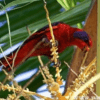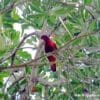Black-winged Lory
Also known as:
Biak Red Lory, Blue-cheeked Lory
Also known as:
Biak Red Lory, Blue-cheeked Lory
DID YOU KNOW?
The island habitats where the Black-winged Lory resides have been almost completely cleared of forest, leaving this species at serious risk of extinction.

Eos

cyanogenia
Size:
31 cm (12.1 in)
Weight:
120 g (4.2 oz)
Subspecies including nominate:
one
Colour Adult:
Both adults in general red; blue/purple stripe from eye to ear coverts; black upper wing coverts, scapulars and tertials; black thighs and flank patches; red underwing coverts and wide underwing band; black central tail feathers, red lateral feathers, margined with black. Beak orange/red. Eye red.
Colour Juvenile:
In general duller than adults with dusty blue/black margins to head, neck and feathers of underparts; black upper wing coverts, tinted with green. Beak orange/brown. Eye brown.
Call:
Calls made in flight are shrill and abrupt; while feeding, repetitious harsh, nasal and up-slurred notes.
More Information:
Content Sources:
CITES
The Lory Link
BirdLife International
Cornell Lab of Ornithology/Birds of the World
Parrots: A Guide to Parrots of the World, Juniper and Parr, 1998
Parrots: Status Survey and Conservation Plan 2000-2004, Snyder, McGowan, Gilardi, Grajal, 2000.
Parrots of the World, Forshaw and Cooper, 1977. 2010 edition
Lexicon of Parrots, Thomas Arndt.
Parrots of the World, Forshaw, 2006.
Parrots in Aviculture, Low, 1992.
Captive Status:
Occasionally available through 1970s and 1980s; less so now.
Longevity:
Probably 25-35 yrs.
Housing:
Enclosure with well-drained concrete or tiled floor, or suspended aviary over same.
Diet:
Nectar such as a commercial type or homemade from: lactose-free baby cereal, honey and malt extract or molasses, mixed with filtered water and made fresh once or twice daily; may add wheat germ to this if desired; fruits once or twice daily such as: apple, pear, pomegranates, bananas, oranges; vegetables such as: carrot; corn on the cob or unsalted tinned sweet corn; green leaves such as: Swiss chard, lettuce, sowthistle, dandelion, chickweed; rearing food made from hardboiled egg, wholegrain bread and carrot, all ground to crumbly consistency.
Enrichment:
Provide overhead misters or shallow bowls of water for bathing. Provide bird-safe, unsprayed flowering branches. Also provide puzzle/foraging toys and easy-to-clean ladders, swings and other toys.
Nest Box Size:
Vertical box 10″ x 10″ x 14″ (25.4 cm x 25.4 cm x 35.5 cm).
Clutch Size:
2
Fledging Age:
11-12 weeks
Hatch Weight:
—
Peak Weight:
—
Weaning Weight:
—
World Population:
11,700-67,400, decreasing.
IUCN Red List Status:
Near Threatened
CITES Listing:
Appendix II
Threat Summary:
A BirdLife “restricted-range” species. Heavily trapped for the wild bird trade particularly on Biak. Is more common elsewhere in its range. Rapid rates of reduction in abundance on Biak between 1982 and 1997 appeared to have slowed in the 2000s. Large-scale deforestation, especially on Numfor and Manim, has likely caused this species’ already small population to decline.
Range:
Islands in Geelvink Bay, West Papua, Indonesia, excluding Yapen Island and New Guinea mainland.
Habitat:
Found up to 460 m (1508 ft) in humid inland forests, along forest edge and in mature secondary growth forest; also seen in coastal coconut plantations, around villages and in areas with scrub vegetation.
Wild Diet:
Diet includes mistletoe berries and nectar from Brugiera gymnorhiza sp.
Ecology and Behaviour:
Generally found singly, in pairs or in small flocks of up to six individuals.
Clutch and Egg Size:
2 rounded eggs, 29.0 x 24.0 mm (1.1 x 0.9 in).
Breeding Season:
Courtship behaviour observed June-July. Nest is likely in tree cavity.
Related Links:
—
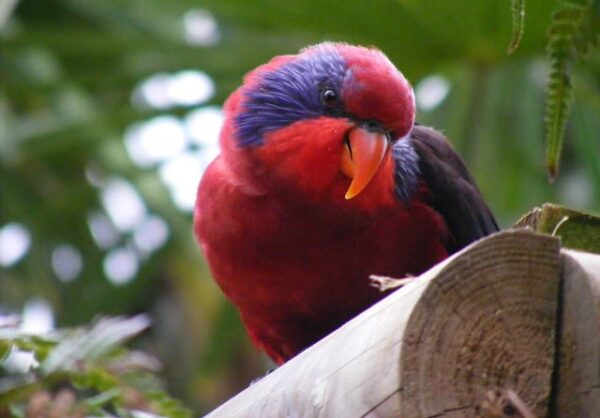
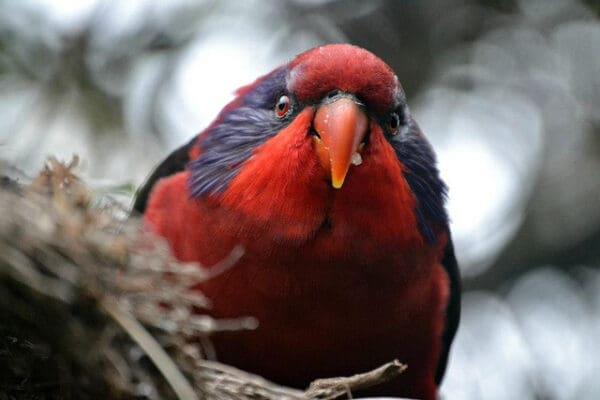
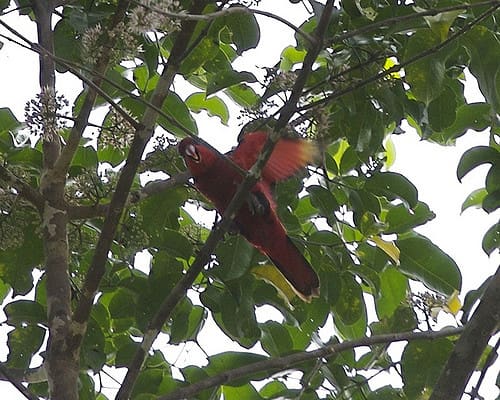
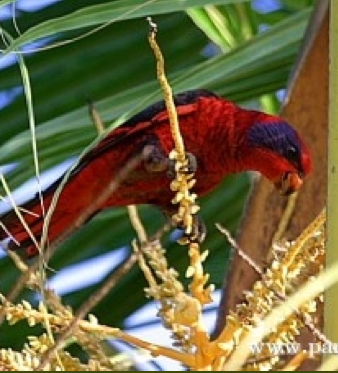
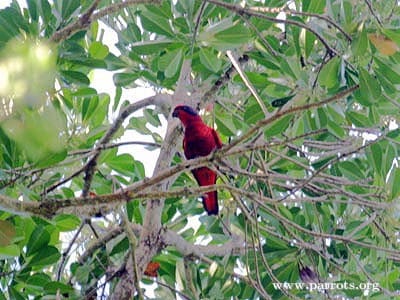
![© Marie Hale [CC BY-SA 2.0] via Flickr A Black-winged Lory at Wingham Wildlife Park, UK perches on a log](https://parrots.org/wp-content/uploads/2023/01/wpt_Black-winged-Lory_1221-6-e1731260135704-100x100.jpg)
![© Laura Grimsley [CC BY-NC-SA 2.0] via Flickr A Black-winged Lory at Wingham Wildlife Park, UK perches on a log](https://parrots.org/wp-content/uploads/2023/01/wpt_Black-winged-Lory_1221-5-100x100.jpg)
![© Lip Kee [CC BY-NC 2.0] via Flickr A wild Black-capped Lory](https://parrots.org/wp-content/uploads/2023/01/wpt_Black-winged-Lory_1221-4-100x100.jpg)
